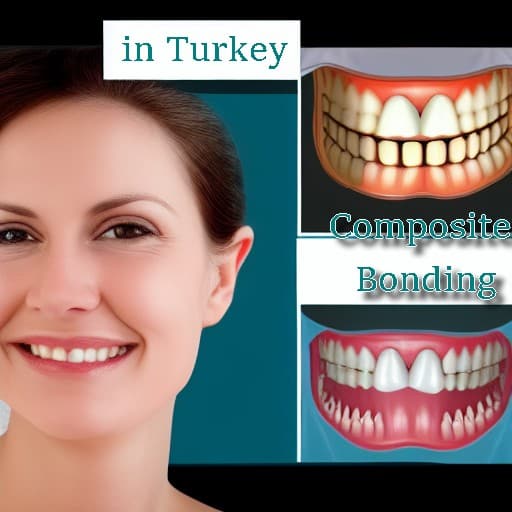Composite bonding is a single-visit restorative dentistry procedure that is used to repair small cracks in teeth. If you have one or more chips or cracks in your teeth, composite bonding can help. It’s also known as resin-modified glass ionomer cement (RMGIC), which indicates the type of materials used during this process. What is composite bonding? Composite bonding is an effective and affordable procedure for repairing small chips or cracks in your teeth, which can be fixed with this type of dental restorative treatment. Read on to learn about the different types of composite bonds and what you should know about them before getting one done.
What is Composite Bonding?
Composite bonding is a dental restoration procedure used to repair small cracks, chips, or gaps in teeth that have been stained or discolored, or that have weakened enamel. This procedure can help restore the strength and appearance of your teeth. Composite bonding uses a tooth-colored resin material to fill the area that has been weakened. The composite resin is applied to the tooth and hardened, which allows it to withstand chewing without cracking or breaking. Composite bonding is also referred to as resin-modified glass ionomer cement (RMGIC). This indicates the type of materials used during the procedure.

Composite Bonding in Turkey
When it comes to composite bonding treatments, the best place for patients to go for treatment is Turkey. Turkish dentists excel in providing quality treatment at a reasonable cost. Yes, composite bonding treatment in Turkey is far cheaper than in other places. You can expect to pay at least 50 percent less than you would in other countries. Composite bonding in Turkey is a single-visit restorative dentistry procedure that is used to repair small cracks in teeth. If you have one or more chips or cracks in your teeth, composite bonding can help. It’s also known as resin-modified glass ionomer cement (RMGIC), which indicates the type of materials used during this process. What is composite bonding? Composite bonding is an effective and affordable procedure for repairing small chips or cracks in your teeth, which can be fixed with this type of dental restorative treatment. Read on to learn about the different types of composite bonds and what you should know about them before getting one done.

Composite bonding cost in Turkey
Composite bonding in Turkey has an composite bonding cost of between $100 and $250. Is composite bonding worth getting in Turkey? Composite bonding in Turkey is renowned for its high quality and low cost, and as a result, many individuals choose to get composite bonding treatment there. Composite bonding in Turkey is well worth it, especially when you add in the mini holiday abroad. Are you thinking about composite bonding in Turkey? A Clinic can help you with composite bonding in Turkey. They can tell you more about teeth boning in Turkey and assist you with booking an appointment.
Types of Composite Bonding
There are several types of composite bonding and they are – – Direct composite bonding – This type of composite bonding involves filling the cracks or gaps with a tooth-colored resin. The resin is applied on the surface of the teeth and hardened. – Indirect composite bonding – In this type of composite bonding, the dentist applies a bonding agent to the tooth first. After the agent has dried, he applies the resin to the tooth. The resin stays on the tooth longer and is hardened using a curing light. – Resin-retained composite bonding – In this type of composite bonding, the dentist fills the gaps or cracks with a tooth-colored resin. However, the resin does not stick to the tooth immediately. The resin stays in place when the dentist attaches a fiber to it. – Resin-modified composite bonding – In this type of composite bonding, the dentist uses resin to fill the gaps or cracks in your teeth. The resin is thicker than the resin used in other types of composite bonding.
Benefits of Composite Bonding
Composite bonding can be used to treat a variety of dental problems, including weak enamel, discoloration, or small chips in the teeth. It’s a quick and easy procedure that can be performed in one visit. Here are some of the benefits of composite bonding – – It’s cost-effective – Composite bonding is an affordable restorative dental procedure. It is less expensive than other dental treatments, such as crowns, veneers, or dental implants. – It’s quick – Composite bonding is a procedure that can be performed in one visit. It’s quicker than other dental treatments, such as dental crowns, veneers, or dental implants. – It preserves tooth structure – While composite bonding repairs small cracks or gaps in teeth, it does not require the removal of tooth structure. – It improves the appearance of teeth – Composite bonding can be used to correct discoloration, stains, and small cracks in teeth. It can also be used to close gaps between teeth.
Disadvantages of Composite Bonding
Composite bonding is not a very long-term dental restoration option. The resin used in this procedure is not as hard as ceramic or porcelain. It can chip or break after a while. Here are some of the disadvantages of composite bonding – – It’s not a long-term dental restoration – Dentists don’t recommend this procedure as a long-term dental restoration option. It can chip or break after a certain period. – It might require multiple treatments – Composite bonding might need to be reapplied after a certain period. This can be an extra cost you might have to incur. – It can discolor or stain – The resin used in composite bonding can discolor or stain over time. It can also chip or break if it comes in contact with too much force.
How much does composite bonding cost?
Composite bonding is an inexpensive dental procedure compared to other dental treatments. Depending on the severity of the problem, the dentist might suggest that you get composite bonding only. The cost of these treatments can vary, but it is less than $500 for both. The cost of composite bonding also depends on where you get it done and the condition of your teeth. If your teeth have a lot of decay or have old fillings, you might have to spend more money on getting the treatment. If you get your treatment done in a dentist’s office, expect to spend between $300 and $500. If you go to a dental school, you might get treatment at a discounted price, but the quality of service might not be as good.
When should you get composite bonding?
Composite bonding can be used to treat a variety of dental problems, including weak enamel, discoloration, or small chips in the teeth. It can be used as a long-term solution for small cracks or gaps in teeth. Here are some situations when you should get composite bonding – – If you have gaps between teeth – Gaps between teeth can be treated with composite bonding. The gaps, if large, can be fixed with a direct composite bonding technique, while smaller gaps can be fixed with an indirect technique. – If you have small cracks in teeth – Small cracks in teeth can be treated with composite bonding. If the cracks are deep or have a large area, you can use direct composite bonding, whereas, for small cracks, you can use indirect bonding. – If you have discoloration in your teeth – Composite bonding can be used to correct discoloration in teeth. It can also be used to close gaps between teeth.
Conclusion
Composite bonding is a quick, one-visit dental procedure that is used to repair small cracks or gaps in teeth. This treatment can also be used to close gaps between teeth. Composite bonding is an affordable dental procedure and can be used on several types of teeth. While it can be an excellent option for some patients, it is important to know about the advantages and disadvantages of this procedure before scheduling treatment.
